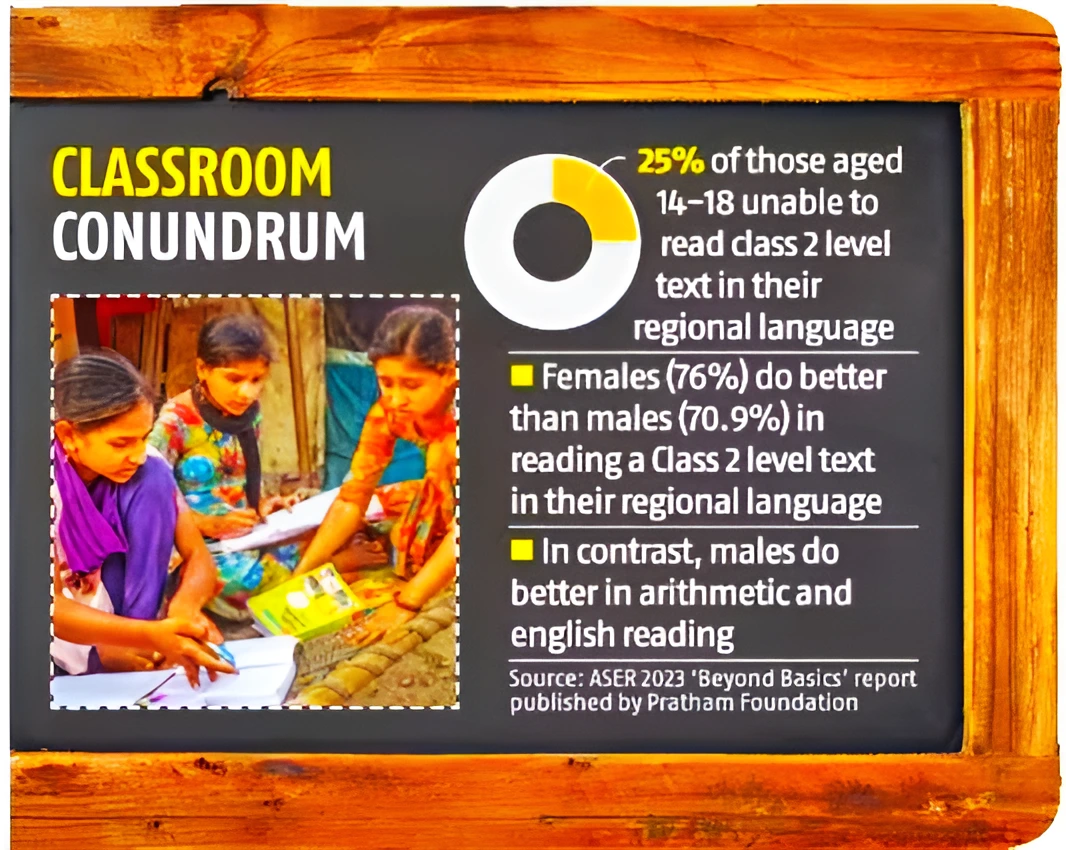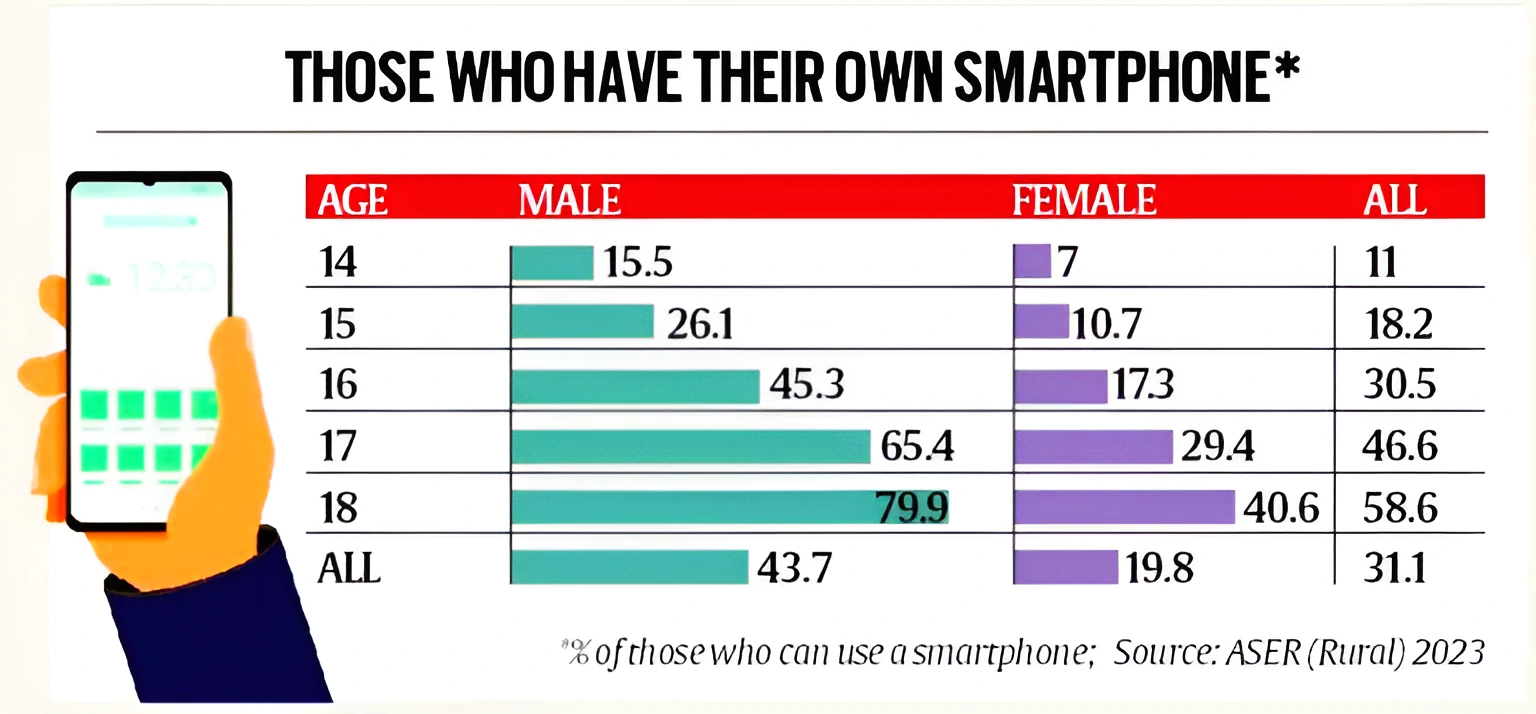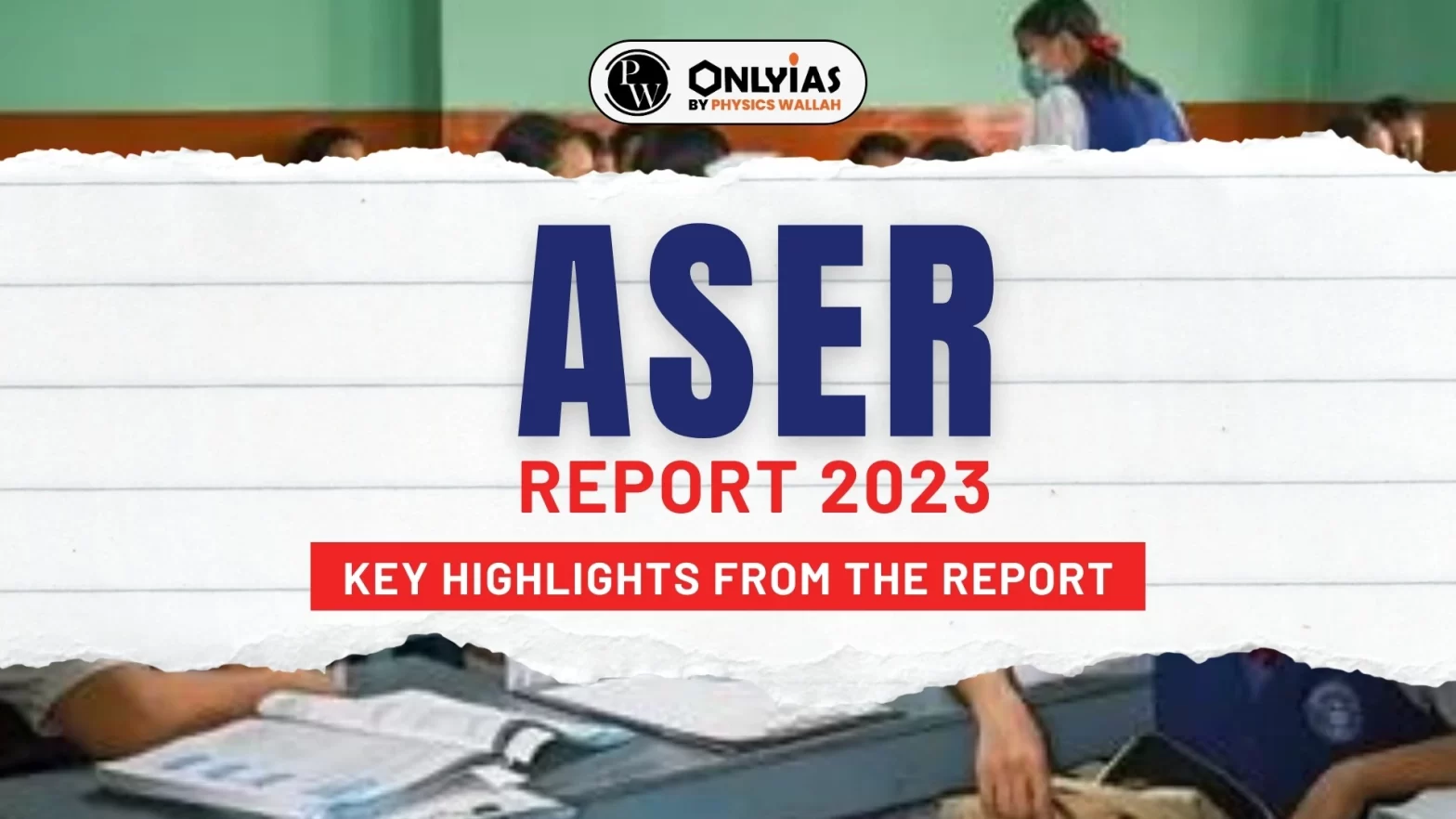Context:
The Annual Status of Education Report (ASER) titled ‘Beyond Basics’ based on a survey led by the Pratham Foundation has been released.
About ASER Report 2023
- Target Age Group: A household survey was conducted among rural students aged 14 to 18 years in 28 districts across 26 states to assess the foundational reading and arithmetic abilities of 34,745 students.
- Focused Domains in Survey: The survey was focused on the following domains:
- Activities: Activities in which India’s youth are currently engaged.
- Awareness and Digital Skills: Awareness of digital technologies and platforms among the youth.
- Educational and career pathways: Aspirations of Indian youth
- Ability to apply foundational skills to daily life situations: Basic and applied reading and math abilities among the youths.
Enroll now for UPSC Online Course
Key Highlights from the ASER Report 2023

- Status of Youth Activities: Across all enrolment categories, a higher proportion of females than males were doing household work daily. Overall, this difference is about 20 percentage points.
- Among males and females, most youth working in activities other than household work tend to be working on family farms.
- It was found that a higher percentage of males (40.3%) than females (28%) had done work other than household work for more than 15 days.
- Around 30% of youth are working for their parents.
- Aspirations: The survey shows that the two most popular choices among the boys and young men in the sample were army (13.8%) and police (13.6%).
- Among the girls and young women surveyed, teacher (16%) and doctor (14.8%) were the most preferred choices.
- Age Gap in Enrollment: Overall, 86.8% of 14-18-year-olds are enrolled in an educational institution. Although the gender gaps in enrolment is small, there are prominent differences by age.
- The percentage of youth not enrolled is 3.9% for 14-year-old youth and is 32.6% for 18-year-olds.
- Choice of Streams: Most people in this age group were enrolled in the Arts/Humanities streams.
- In Class XI or higher, more than half are enrolled in the Arts/Humanities stream (55.7%) and females are less likely to be enrolled in the Science, Technology, Engineering, and Mathematics stream (28.1%) than males (36.3%).
- Status Of Vocational Training: Only 5.6% of surveyed youth are taking vocational training or other related courses.
-
- The vocational training is most likely to be taken by the youth at the college level(16.2%). Moreover, most youth are taking short duration courses of six months or less.
 Assessment of Basic Skills and Literacy levels: About 25% of this age group cannot read a standard II-level text fluently in their regional language.
Assessment of Basic Skills and Literacy levels: About 25% of this age group cannot read a standard II-level text fluently in their regional language.
- Across enrollment categories, females (76%) do better than males (70.9%) in reading a Std II level text in their regional language.
- English Reading Skills: Around 57.3% can read English sentences. Of those who can read in English, nearly three-quarters (73.5%) are able to understand the meaning of the sentences.
- Division Problems: More than half among 14-18-year-old youth struggle with division (3-digit by 1-digit) problems wherein only 43.3% are able to do such problems correctly.
- In 2017, 39.5 percent of youth could do a superficial (grade 3-4 level) division problem, while in 2023, this proportion went up to 43.3%.
- Applying Foundational Skills to Daily Life: Two-thirds of the surveyed youths (65.1 per cent) were able to read functional instructions on a packet of ORS solution.
 Digital Divide in Smartphone Proficiency: About 90% of surveyed households had smartphones. Of the surveyed children, almost 95% boys and 90% girls could use a smartphone.
Digital Divide in Smartphone Proficiency: About 90% of surveyed households had smartphones. Of the surveyed children, almost 95% boys and 90% girls could use a smartphone.
- Among those who can use a smartphone, two-thirds reported using it for an education-related activity during the reference week, such as watching online videos related to studies, solving doubts, or exchanging notes.
Also Refer: Should There Be A Blanket Ban On Smartphones In Schools
What Challenges Are Highlighted in the ASER Report 2023?
- No Improvement in Foundational Literacy and Numeracy Skills (FLN): There has been no significant change in student’s FLN.
- According to the report, in 2017, 76.6 per cent of 14-18-olds could read a grade 2-level text, while in 2023, this number reduced to 73.6%.
- Low levels of foundational numeracy affect the ability of youth in tackling everyday calculations where they need to apply measurement or use the unitary method in practical situations.
- Poor Quality Labourforce: This deficit in foundational numeracy significantly impacts the quality of the country’s labour force.
- Balancing Academics and Family Responsibilities: Most of the youths face compounded challenges as they need to balance academic requirements with responsibilities, such as working in family farms. These responsibilities impact the aspirations of youth.
- Poor Utilisation of Smartphones for Education Purpose: The current use of smartphones for educational purposes is significantly lower than that for entertainment.
- Close to 80% reported using their smartphone for an entertainment-related activity, such as watching a movie or listening to music.
- Gender Disparity in Reading and Arithmetic Skills: Males performed better than females in arithmetic and English reading across most of the tasks that test the ability to apply basic numeracy and reading skills.
- For instance, only 41.1% females were able to tell the time compared to 51% males. Similarly, 88% males were able to measure length compared to 82% women.
- Gender Disparity in Digital Skills: Of those who can use a smartphone, 43.7% of males own smartphones as compared to 19.8% of females.
- Across all phone-related tasks assigned to respondents, boys outperformed girls.
- Performance in digital tasks improved with education level. Ability to perform digital tasks also increased with basic reading proficiency.
About ASER Reports
- ASER is a nationwide citizen-led household survey that provides the status of children’s schooling and learning in rural India.
- ASER Full Form: Annual Status of Education Report
- Released by: NGO Pratham Foundation.
- Initiation: First implemented in 2005, the ‘basic’ ASER survey was conducted annually until 2014 and switched to an alternate-year cycle in 2016.
- Data Collection Focus:
- Enrolment status of children (3-16 years).
- Basic reading and arithmetic levels (5-16 years).
- Significance: They are used by the government while formulating policies.
|
Way Forward
- Reorienting Vocational Education: As highlighted in the report, youth are not prioritizing vocational skilling as only 5.6% are currently enrolled in vocational courses.
- This highlights the need for policymakers to rethink vocational education, aligning it with the aspirations outlined in the National Education Policy (NEP) to make it genuinely aspirational.
- For this, secondary schools need to collaborate with Industrial Training Institutes (ITIs), Polytechnics, Local Industry, etc.
- Skill labs should be set up and created in the schools in a Hub and Spoke model, which will allow other schools to use the facility.
- Higher education institutions should offer vocational education either on their own or in partnership with industry.
- Empowering Underprivileged Learners: The need is to enable the underprivileged to be able to study while working to earn a living.
- Open schooling and digital technology is a powerful combination. The open school and open university processes need to be decentralised and strengthened.
- Need for Non-Formal Education: There is a need for non-formal education to supplement the formal processes of education or fulfil other needs.
- For example, agriculture, or broadly natural resource management, is a subject that is not offered in rural schools and colleges, at least on the scale it should be.
- The ASER Report 2023 reveals that only 0.7% of rural students reported studying agriculture.
- Smartphone Usage and Education Opportunities: The ASER report identifies the widespread use of smartphones in rural areas as an opportunity to extend education.
- Thus, there is a need to encourage the use of digital technologies for learning.
- Tracking Digital Technology Usage and Promoting Constructive Use: The teachers and civil society need to play a role in creating awareness regarding the constructive use of digital technologies.
- For this, digital literacy workshops can be organised for educating students on responsible online behavior, critical thinking skills, and responsible app usage.
Enroll now for UPSC Online Classes
Also Refer: Parliamentary Standing Committee Report on New Education Policy
Conclusion
Thus, prudent reforms in technical and vocational education and training systems are needed to provide support to youths in building foundational literacy and numeracy skills which are essential for academic improvement as well as for meeting everyday needs.
![]() 18 Jan 2024
18 Jan 2024


 Assessment of Basic Skills and Literacy levels: About 25% of this age group cannot read a standard II-level text fluently in their regional language.
Assessment of Basic Skills and Literacy levels: About 25% of this age group cannot read a standard II-level text fluently in their regional language.
 Digital Divide in Smartphone Proficiency: About 90% of surveyed households had smartphones. Of the surveyed children, almost 95% boys and 90% girls could use a smartphone.
Digital Divide in Smartphone Proficiency: About 90% of surveyed households had smartphones. Of the surveyed children, almost 95% boys and 90% girls could use a smartphone.